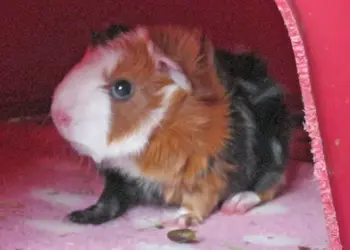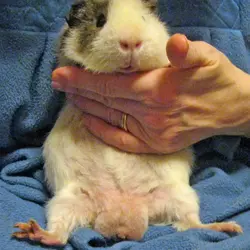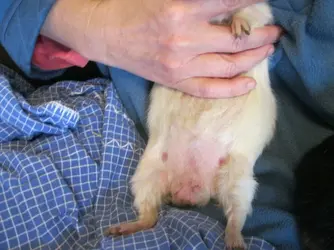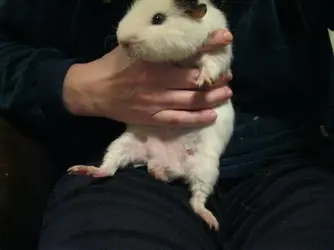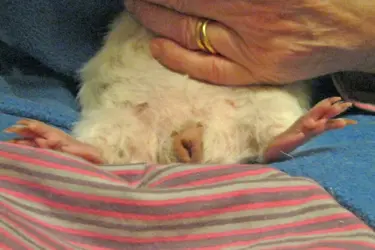Introduction
1 Neutered Boars
- Myths and facts
- When is boar neutering useful?
2 Neutering Operations
- Finding the right vet
- Operation costs
- Neutering age
- The operation
- Post-op care and recovery (with list of possible neutering complications)
- The necessary 6 weeks post-op wait
3 A Real Life Example
- How a problem-free recovery looks ike
- Post-op teenage behaviour
Conclusion
Introduction
Many people with fighting teenage boars are still advised to neuter their boars by general vets that are not familiar with the big difference between rabbit and guinea pig social behaviours.
Neutered boars are also much touted as peace-makers in sow groups; this has unfortunately got its limits as I know from my own rich experience in this respect!
The first part of this guide is looking at all the myths still surrounding neutered boars and in which scenarios and for which purposes neutering and neutered boars actually make sense.
In a second part, this guide is looking at neutering operations, again trying to sort myths from fact considering that most online information available is in no way representative. There are unfortunately plenty of horror stories around, but hardly any accounts of the vast majority of successful operations that go without a hitch and that usually go unreported for exactly that reason!
This part looks at how you can minimise operation risks, the range of cost to expect, neutering ages, how you can prepare and what to look out for during recovery as well as the important post-op safety wait.
Thirdly, I am going to demonstrate by the example of my own teenage boar Nye in 2017 how a problem-free neutering operation should look like and to which extent it has influenced his behaviour post-op. This part contains pictures of the recovery process as well as a couple of short videos from immediately after the operation and from his teenage behaviour a bit later on.
1 Neutered boars
Myths and facts
Myth: Neutering fighting boars will calm them down and enable them to live together happily
Fact: Neutering does most definitely NOT calm down boars in the short run and does NOT turn feuding boars into best friends!
It does in no way change their social behaviour, their personal chemistry or their personalities – two dominant boars will inevitably clash, whether they are brothers or unrelated, neutered or not!
Key to any successful boar bond is mutual liking and character compatibility – both factors that neutering cannot influence and that pet shops and for sale breeders fail to address.
If you struggle with your boars, you will find this very detailed guide here helpful. It is looking at the various phases of the teenage months and at bonds in crisis: what you can and can’t do to stabilise a bond and what options you have after a permanent fall-out, each with their individual pros and cons.
Boars: Teenage, Bullying, Fighting, Fall-outs And What Next?
Myth: Neutered boars can save a struggling sow bond or group.
Fact: A boar is not part of the sow hierarchy in a group. He acts as a natural outsider and he needs to be accepted by all sows. He can act as an integrator and as an absorber for seasonal sow grumpiness to a certain extent. That is so far correct.
However: A boar will NOT make your bickering sows become fast friends! Any divisions within a sow group or pair will remain. Your boar will take care to be on good terms with the lead sow and mostly associate with the sow he likes most or that decides that she is in love with him!
A ‘husboar’ will step into a dispute only if he is also the patriarch and like a first lady, there is only so much he can do if a friction turns into an open feud. More often than not, he will keep out of any sow-only feuds.
I have also had to eventually split several sows in those cases where a dominant ‘husboar’ had taken a dislike to them because they haven’t accepted him and submitted to him instantly; this grudge has been carried through over years and has eventually ended in open bullying at least twice.
Myth: Two neutered boars can live with one, two or more bonded sows
Fact: If you are one of the very few lucky ones with a huge cage and two very laid-back/submissive boars, an old age pensioners (5-6 years plus where the testosterone has run out) group or a disabled/carer piggy setting with different dynamics, you can count yourself lucky! The VAST majority of these kinds of foursomes will end in bad fights!
Unless you can provide the kind of really large habitat that takes up about half a room or even a whole room in a larger group, you are bound to fail.
You can either keep the sows in a pair (preferably well away and ideally on a lower level) to the the boars or bond each boar with a sow in separate pairs.
But there is no easy one cage solution for two boars and two sows!
Myth: Neutered boars don’t smell
Fact: Neutered boars indeed don’t have quite as much full-on aroma compared to an unneutered boar and because of their shrunk anal sac, they are much less prone to collect as much gunk in there!
But they can still generate the most amazing cloud of testosterone if they get excited!
I prefer to do any boar introductions outside or in a room with open windows, as the testosterone laden pee with which excited boars spray the sows and anything around them can be on the overwhelming side!
Myth: Neutered boars don’t get impaction
Fact: About 10% of older boars develop mild or more severe impaction as the muscles at the back weaken. This happens irrespective of whether your boar is neutered or not.
But because the anal sac in a neutered boar has contracted again once his testicles have been removed, impaction cannot build up as badly as in a full boar; the impaction mass is only about pea-sized and much easier to clear out.
For impaction care, please see this guide here: Impaction Recovery - How To Help Your Guinea Pig.
1 Neutered Boars
- Myths and facts
- When is boar neutering useful?
2 Neutering Operations
- Finding the right vet
- Operation costs
- Neutering age
- The operation
- Post-op care and recovery (with list of possible neutering complications)
- The necessary 6 weeks post-op wait
3 A Real Life Example
- How a problem-free recovery looks ike
- Post-op teenage behaviour
Conclusion
Introduction
Many people with fighting teenage boars are still advised to neuter their boars by general vets that are not familiar with the big difference between rabbit and guinea pig social behaviours.
Neutered boars are also much touted as peace-makers in sow groups; this has unfortunately got its limits as I know from my own rich experience in this respect!
The first part of this guide is looking at all the myths still surrounding neutered boars and in which scenarios and for which purposes neutering and neutered boars actually make sense.
In a second part, this guide is looking at neutering operations, again trying to sort myths from fact considering that most online information available is in no way representative. There are unfortunately plenty of horror stories around, but hardly any accounts of the vast majority of successful operations that go without a hitch and that usually go unreported for exactly that reason!
This part looks at how you can minimise operation risks, the range of cost to expect, neutering ages, how you can prepare and what to look out for during recovery as well as the important post-op safety wait.
Thirdly, I am going to demonstrate by the example of my own teenage boar Nye in 2017 how a problem-free neutering operation should look like and to which extent it has influenced his behaviour post-op. This part contains pictures of the recovery process as well as a couple of short videos from immediately after the operation and from his teenage behaviour a bit later on.
1 Neutered boars
Myths and facts
Myth: Neutering fighting boars will calm them down and enable them to live together happily
Fact: Neutering does most definitely NOT calm down boars in the short run and does NOT turn feuding boars into best friends!
It does in no way change their social behaviour, their personal chemistry or their personalities – two dominant boars will inevitably clash, whether they are brothers or unrelated, neutered or not!
Key to any successful boar bond is mutual liking and character compatibility – both factors that neutering cannot influence and that pet shops and for sale breeders fail to address.
If you struggle with your boars, you will find this very detailed guide here helpful. It is looking at the various phases of the teenage months and at bonds in crisis: what you can and can’t do to stabilise a bond and what options you have after a permanent fall-out, each with their individual pros and cons.
Boars: Teenage, Bullying, Fighting, Fall-outs And What Next?
Myth: Neutered boars can save a struggling sow bond or group.
Fact: A boar is not part of the sow hierarchy in a group. He acts as a natural outsider and he needs to be accepted by all sows. He can act as an integrator and as an absorber for seasonal sow grumpiness to a certain extent. That is so far correct.
However: A boar will NOT make your bickering sows become fast friends! Any divisions within a sow group or pair will remain. Your boar will take care to be on good terms with the lead sow and mostly associate with the sow he likes most or that decides that she is in love with him!
A ‘husboar’ will step into a dispute only if he is also the patriarch and like a first lady, there is only so much he can do if a friction turns into an open feud. More often than not, he will keep out of any sow-only feuds.
I have also had to eventually split several sows in those cases where a dominant ‘husboar’ had taken a dislike to them because they haven’t accepted him and submitted to him instantly; this grudge has been carried through over years and has eventually ended in open bullying at least twice.
Myth: Two neutered boars can live with one, two or more bonded sows
Fact: If you are one of the very few lucky ones with a huge cage and two very laid-back/submissive boars, an old age pensioners (5-6 years plus where the testosterone has run out) group or a disabled/carer piggy setting with different dynamics, you can count yourself lucky! The VAST majority of these kinds of foursomes will end in bad fights!
Unless you can provide the kind of really large habitat that takes up about half a room or even a whole room in a larger group, you are bound to fail.
You can either keep the sows in a pair (preferably well away and ideally on a lower level) to the the boars or bond each boar with a sow in separate pairs.
But there is no easy one cage solution for two boars and two sows!
Myth: Neutered boars don’t smell
Fact: Neutered boars indeed don’t have quite as much full-on aroma compared to an unneutered boar and because of their shrunk anal sac, they are much less prone to collect as much gunk in there!
But they can still generate the most amazing cloud of testosterone if they get excited!
I prefer to do any boar introductions outside or in a room with open windows, as the testosterone laden pee with which excited boars spray the sows and anything around them can be on the overwhelming side!
Myth: Neutered boars don’t get impaction
Fact: About 10% of older boars develop mild or more severe impaction as the muscles at the back weaken. This happens irrespective of whether your boar is neutered or not.
But because the anal sac in a neutered boar has contracted again once his testicles have been removed, impaction cannot build up as badly as in a full boar; the impaction mass is only about pea-sized and much easier to clear out.
For impaction care, please see this guide here: Impaction Recovery - How To Help Your Guinea Pig.
